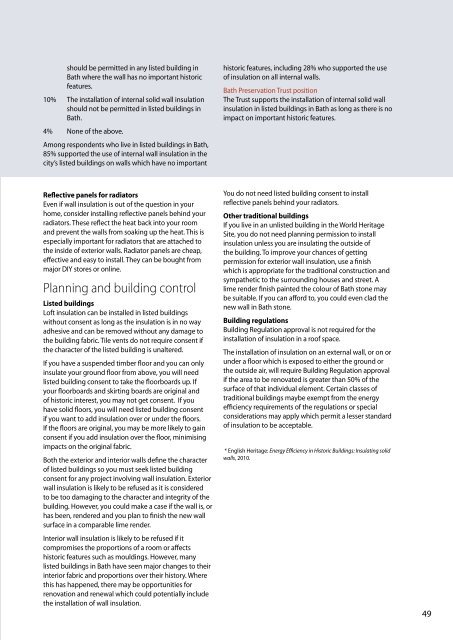Warmer Bath
Create successful ePaper yourself
Turn your PDF publications into a flip-book with our unique Google optimized e-Paper software.
Improving the energy efficiency of traditional homes in the City of <strong>Bath</strong><br />
should be permitted in any listed building in<br />
<strong>Bath</strong> where the wall has no important historic<br />
features.<br />
10% The installation of internal solid wall insulation<br />
should not be permitted in listed buildings in<br />
<strong>Bath</strong>.<br />
4% None of the above.<br />
Among respondents who live in listed buildings in <strong>Bath</strong>,<br />
85% supported the use of internal wall insulation in the<br />
city’s listed buildings on walls which have no important<br />
historic features, including 28% who supported the use<br />
of insulation on all internal walls.<br />
<strong>Bath</strong> Preservation Trust position<br />
The Trust supports the installation of internal solid wall<br />
insulation in listed buildings in <strong>Bath</strong> as long as there is no<br />
impact on important historic features.<br />
Reflective panels for radiators<br />
Even if wall insulation is out of the question in your<br />
home, consider installing reflective panels behind your<br />
radiators. These reflect the heat back into your room<br />
and prevent the walls from soaking up the heat. This is<br />
especially important for radiators that are attached to<br />
the inside of exterior walls. Radiator panels are cheap,<br />
effective and easy to install. They can be bought from<br />
major DIY stores or online.<br />
Planning and building control<br />
Listed buildings<br />
Loft insulation can be installed in listed buildings<br />
without consent as long as the insulation is in no way<br />
adhesive and can be removed without any damage to<br />
the building fabric. Tile vents do not require consent if<br />
the character of the listed building is unaltered.<br />
If you have a suspended timber floor and you can only<br />
insulate your ground floor from above, you will need<br />
listed building consent to take the floorboards up. If<br />
your floorboards and skirting boards are original and<br />
of historic interest, you may not get consent. If you<br />
have solid floors, you will need listed building consent<br />
if you want to add insulation over or under the floors.<br />
If the floors are original, you may be more likely to gain<br />
consent if you add insulation over the floor, minimising<br />
impacts on the original fabric.<br />
Both the exterior and interior walls define the character<br />
of listed buildings so you must seek listed building<br />
consent for any project involving wall insulation. Exterior<br />
wall insulation is likely to be refused as it is considered<br />
to be too damaging to the character and integrity of the<br />
building. However, you could make a case if the wall is, or<br />
has been, rendered and you plan to finish the new wall<br />
surface in a comparable lime render.<br />
Interior wall insulation is likely to be refused if it<br />
compromises the proportions of a room or affects<br />
historic features such as mouldings. However, many<br />
listed buildings in <strong>Bath</strong> have seen major changes to their<br />
interior fabric and proportions over their history. Where<br />
this has happened, there may be opportunities for<br />
renovation and renewal which could potentially include<br />
the installation of wall insulation.<br />
You do not need listed building consent to install<br />
reflective panels behind your radiators.<br />
Other traditional buildings<br />
If you live in an unlisted building in the World Heritage<br />
Site, you do not need planning permission to install<br />
insulation unless you are insulating the outside of<br />
the building. To improve your chances of getting<br />
permission for exterior wall insulation, use a finish<br />
which is appropriate for the traditional construction and<br />
sympathetic to the surrounding houses and street. A<br />
lime render finish painted the colour of <strong>Bath</strong> stone may<br />
be suitable. If you can afford to, you could even clad the<br />
new wall in <strong>Bath</strong> stone.<br />
Building regulations<br />
Building Regulation approval is not required for the<br />
installation of insulation in a roof space.<br />
The installation of insulation on an external wall, or on or<br />
under a floor which is exposed to either the ground or<br />
the outside air, will require Building Regulation approval<br />
if the area to be renovated is greater than 50% of the<br />
surface of that individual element. Certain classes of<br />
traditional buildings maybe exempt from the energy<br />
efficiency requirements of the regulations or special<br />
considerations may apply which permit a lesser standard<br />
of insulation to be acceptable.<br />
* English Heritage: Energy Efficiency in Historic Buildings: Insulating solid<br />
walls, 2010.<br />
49


